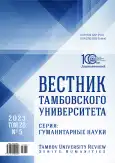Organizational and pedagogical conditions for teaching students types of foreign language communicative activity based on dictogloss
- 作者: Aksenova I.N.1
-
隶属关系:
- Moscow Pedagogical State University
- 期: 卷 28, 编号 5 (2023)
- 页面: 1129-1141
- 栏目: THEORY AND METHODS OF FOREIGN LANGUAGE TEACHING
- URL: https://bakhtiniada.ru/1810-0201/article/view/297920
- DOI: https://doi.org/10.20310/1810-0201-2023-28-5-1129-1141
- ID: 297920
如何引用文章
全文:
详细
Importance. The students’ foreign language communicative abilities development is the main goal of a foreign language teaching at a language university. The dictogloss as a means of a foreign language teaching is actively used for the speech skills progression, since it involves the participation of all four types of speech activities: reading, listening, speaking and writing. The dictogloss technique meets the requirements of a task-oriented approach to learning and involves the implementation of students’ independent activities, both individual and group, in the informational educational environment. However, in the modern methodical literature there are no installation requirements that determine the dictogloss use effectiveness as a means of a foreign language teaching. The purpose of the research is to identify a number of organizational and pedagogical conditions for teaching students types of foreign language communicative activity based on dictogloss.Research Methods. Using the methods of scientific literature theoretical analysis on the research topic, as well as a comparative analysis of the conceptual provisions of modern approaches to teaching, the organizational and pedagogical conditions for teaching students types of foreign language communicative activity based on dictogloss are empirically identified.Results and Discussion. The research describes a number of organizational and pedagogical conditions for teaching students types of foreign language communicative activity based on dictogloss. Mentioned conditions include the following aspects: a) students’ proficiency in a foreign language at level B1 and higher; b) compliance with a clearly defined sequence of learning stages; c) development of students and teachers linguocomputer competence; d) motivation of students to participate in language teaching through foreign language educational interaction; e) combined use of full-time and distance learning formats.Conclusion. Teaching students types of foreign language communicative activity based on dictogloss is carried out in compliance with the above organizational and pedagogical conditions. The obtained results can be used in further research on the dictogloss integration in methods of a foreign language teaching.
作者简介
I. Aksenova
Moscow Pedagogical State University
编辑信件的主要联系方式.
Email: ingaksenova@yandex.ru
ORCID iD: 0000-0003-2358-9383
Lecturer of Foreign Languages Department
1 bldg, 1 Malaya Pirogovskaya St., Moscow, 119991, Russian Federation参考
- Azimov E.G., Shchukin A.N. (2009). Novyi slovar’ metodicheskikh terminov i ponyatii (teoriya i praktika obu-cheniya yazykam) [New Dictionary of Methodical Terms and Concepts (Theory and Practice of Language Teaching)]. Moscow, Ikar Publ., 448 p. (In Russ.) https://elibrary.ru/xqrftt
- Long M.H. (2005). Second Language Needs Analysis. Cambridge, Cambridge University Press, 374 p. https://doi.org/10.1017/CBO9780511667299
- Lightbown P.M., Spada N. (1999). How Languages are Learned. Oxford, Oxford University Press, 192 p.
- Nunan D. (1989). Designing Tasks for the Communicative Classroom. Glasgow, Cambridge University Press, 211 p.
- Canale M., Swaine M. (1980). Theoretical bases of communicative approaches to second language teaching and testing. Applied Linguistics, vol. 1, no. 1, pp. 1-47. https://doi.org/10.1093/applin/I.1.1
- Gagné R.M. (1977). The Conditions of Learning. New York, Holt, Rinehart and Winston Publ., 339 p.
- Hattie J.C. (2008). Visible Learning: A Synthesis of Over 800 Meta-Analyses Relating to Achievement. London, Routledge Publ., 392 p. https://doi.org/10.4324/9780203887332
- Thorne S.L., Black R.W. (2008). Language and literacy development in computer-mediated contexts and com-munities. Annual Review of Applied Linguistics, vol. 28, pp. 133-160. https://doi.org/10.1017/S0267190508070074
- Sysoev P.V., Evstigneev M.N. (2010). Metodika obucheniya inostrannomu yazyku s ispol’zovaniem novykh in-formatsionno-kommunikatsionnykh internet-tekhnologii [Methods of Teaching a Foreign Language Using New Information and Communication Internet Technologies]. Moscow, Glossa-Press, 182 p. (In Russ.) https://elibrary.ru/quxtab
- Titova S.V. (2022). The map of competencies of a foreign language university teacher in the context of digitali-zation of education. Vysshee obrazovanie v Rossii = Higher Education in Russia, vol. 31, no. 5, pp. 133-149. (In Russ.) https://doi.org/10.31992/0869-3617-2022-31-5-133-149, https://elibrary.ru/jmljrw
- Sysoev P.V., Polyakov O.G., Evstigneev M.N. et al. (2023). Obuchenie inostrannomu yazyku na osnove tekhno-logii iskusstvennogo intellekta [Foreign Language Teaching on the Basis of Artificial Intelligence Technologies]. Tambov, Publishing House “Derzhavinsky”, 132 p. (In Russ.) https://elibrary.ru/xldywn
- Evstigneev M.N. (2020). Kompetentnost’ uchitelya inostrannogo yazyka v oblasti ispol’zovaniya distantsion-nykh tekhnologii na sovremennom etape [Foreign Language Teacher Competence in the Distance Technologies Use at the Present Stage]. Inostrannye yazyki v shkole = Foreign Languages at School, no. 9, pp. 80-90. (In Russ.) https://elibrary.ru/dkgzev
- Glasser W. (1984). Motivation and learning. Review of Educational Research, vol. 54, no. 3, pp. 363-386.
- Vygotskii L.S. (1982). Izbrannye psikhologicheskie issledovaniya [Selected Psychological Research]. Moscow, Pedagogika Publ. (In Russ.)
- Sysoev P.V. (2008). Yazykovoe polikul’turnoe obrazovanie: Teoriya i praktika [Linguistic Multicultural Educa-tion: Theory and Practice]. Moscow, Glossa-Press, 385 p. (In Russ.) https://elibrary.ru/vjorzn
- Evstigneev M.N., Evstigneeva I.A. (2021). Distance learning technologies in foreign language teaching. Vestnik Tambovskogo universiteta. Seriya: Gumanitarnye nauki = Tambov University Review. Series: Humanities, vol. 26, no. 190, pp. 25-32. (In Russ.) https://doi.org/10.20310/1810-0201-2021-26-190-25-32, https://elibrary.ru/jrrzcn
- Tomlinson B., Whittaker C. (2013). Blended Learning in English Language Teaching: Course Design and Im-plementation. London, British Council Publ., 258 p.
- Garrison D., Vaughan N. (2008). Blended Learning in Higher Education: Framework, Principles, and Guide-lines. San Francisco, Jossey-Bass Publ., 245 p. http://dx.doi.org/10.1002/9781118269558
- Aksenova I.N. (2019). Linguodidactic potential of the complex task “dictogloss”. Vestnik Tambovskogo univer-siteta. Seriya: Gumanitarnye nauki = Tambov University Review. Series: Humanities, vol. 24, no. 180, pp. 70-78. (In Russ.) https://doi.org/10.20310/1810-0201-2019-24-180-70-78, https://elibrary.ru/fknybs
补充文件









